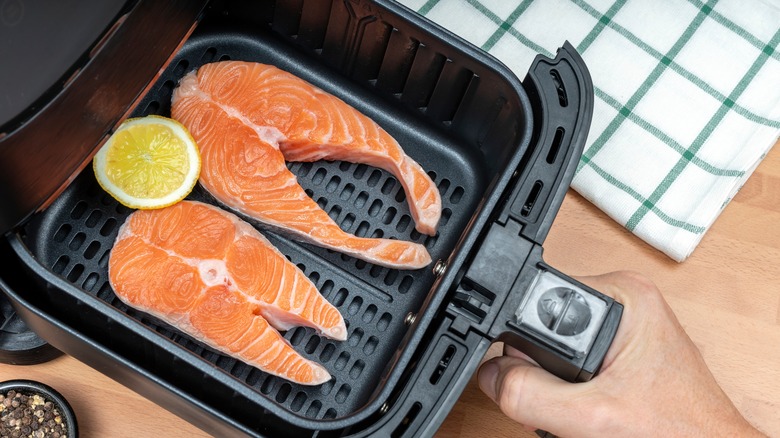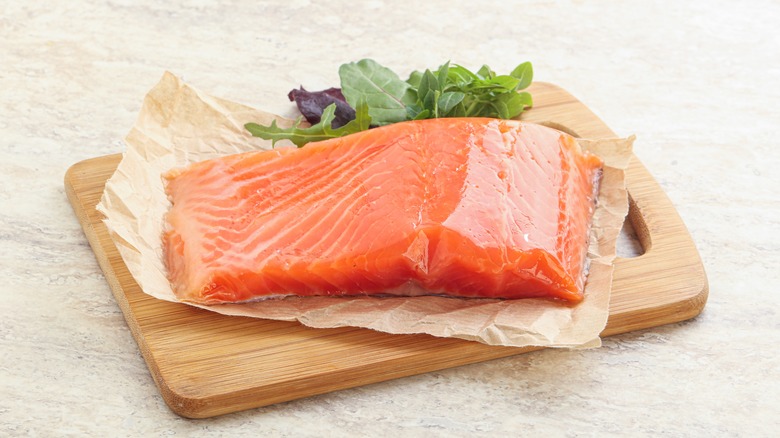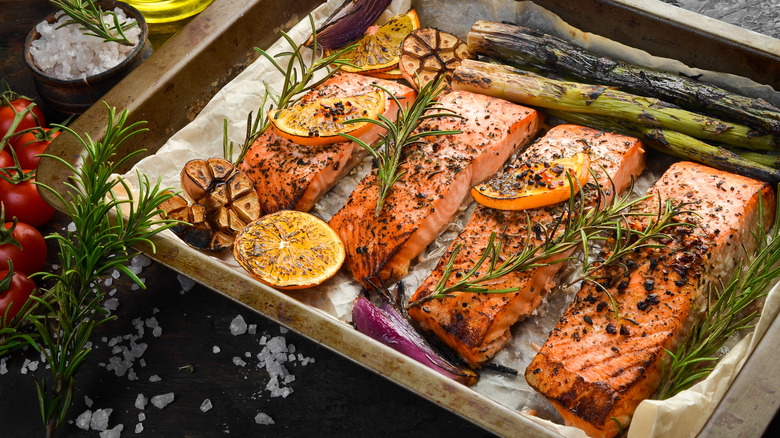How Long To Cook Salmon In An Air Fryer Based On Fillet Size
Air fryers have skyrocketed in popularity over the past decade, but the transition from conventional oven to fryer can be a little rocky sometimes. Traditional oven-cooked recipes suggest a temperature and time when food is prepared this way, but that doesn't always translate to an air fryer. This is especially true when it comes to cooking delicate proteins like salmon.
The rule of thumb for cooking salmon fillets in an oven is generally 10 minutes per inch of thickness at 425 degrees Fahrenheit. Following this standard should get a fillet to the recommended internal temperature of 145 degrees Fahrenheit. However, using the same time and temperature in an air fryer will simply result in a dried-out piece of fish. This discrepancy is due to the fact that an air fryer has a compact size that heats up and cooks food faster than a traditional oven.
There is a simple way to convert oven recipes to air fryer recipes, however; just reduce the temperature by 25 degrees Fahrenheit and cut the cooking time by 20%. For a 1-inch thick salmon fillet, that would equate to eight minutes at 400 degrees. This works not only for salmon, but also for most poultry, pork, and other fish recipes like grilled Chilean sea bass.
Uneven salmon fillets require some extra preparation
It's good to know that not all salmon fillets are created equal and won't always cook correctly in an air fryer without some intervention. While some cuts are uniformly thick, others can have a much thinner dimension, resulting in uneven cooking. In order to combat this, some fillet surgery is required. The simplest solution is to cut off the thinner side of the fish so that there is the same level of thickness on the bigger piece. But, during cooking, the thin pieces should be closely monitored because they need less time to process.
A second option is to fold the thin end under the fillet. To do so, score the thin end with a knife without fully cutting through the entire fish. Folding along that line will create a more uniform thickness throughout the entire piece. With this method, it's recommended to remove the skin which might be a struggle for some home cooks; not everyone has the knife skills required for this task. However, there is an easy hack: Place a cooking rack over a bowl or casserole pan and put the salmon on the rack, skin side up. Then pour boiling water over the skin; the heat will quickly make it shrivel and, after a few seconds, it easily can be peeled off.
Salmon recipes for the air fryer
Most salmon recipes that require a conventional oven can be converted to an air fryer method with only a few changes. In addition to the aforementioned time and temperature changes, there needs to be some adjustments to the spices. The air fryer lives up to its name with a lot of air blowing around, which can disrupt any dry spices adorning the fillets. But, lightly brushing oil or adding a spritz of lemon juice will bind the spices to the fish so they stick.
Another thing to consider is size. Air fryers are significantly smaller than ovens. If they are overfilled, the contents can stifle the airflow and drastically affect cooking time. This means the air fryer might not be the best choice for large family dinners because it would require batch cooking. Consider halving a conventional oven recipe to avoid fluctuations in heat.
Also, baking salmon in an oven is easy for recipes that are sauce heavy. The same can't be said for the air fryer. While it is perhaps possible with some clever tin foil use, the circulating hot air will splatter the sauces everywhere, causing quite a mess. The best course of action here is to season and cook the fillets in the fryer while making the sauce on the stovetop, and pouring it over the fish after it has finished cooking.
These adjustments are worth it: Air fryer salmon, when cooked properly, is wonderfully soft, flaky, and delicious.



